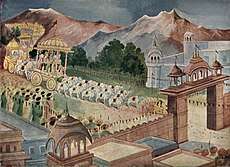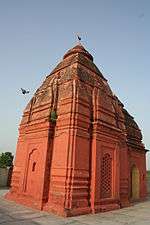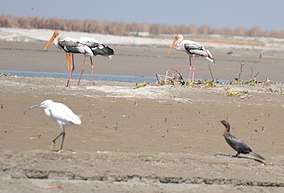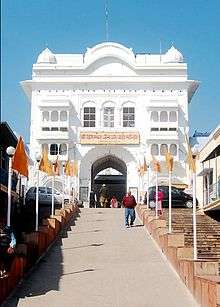Hastinapur
Hastinapur is a city in the Meerut district in the Indian state of Uttar Pradesh. Hastinapur, described in Hindu texts such as the Mahabharata and the Puranas as the capital of the Kuru Kingdom, is also mentioned in ancient Jain texts. Hastinapur is located on the right bank of the Ganges river.
Hastinapur | |
|---|---|
 Kailash Parvat Rachna | |
 Hastinapur Location in Uttar Pradesh, India  Hastinapur Hastinapur (Uttar Pradesh) | |
| Coordinates: 29.17°N 78.02°E | |
| Country | |
| State | Uttar Pradesh |
| District | Meerut |
| Elevation | 212 m (696 ft) |
| Population (2011) | |
| • Total | 58,452 |
| Languages | |
| • Official | Hindi and English |
| Time zone | UTC+5:30 (IST) |
| PIN | 250404 |
| Vehicle registration | UP-15 |
Etymology
In Sanskrit, Hastinapur translates to 'the City of Elephants' from Hastina (elephant) and puram (city). Its history dates back to the period of Mahabharata.[1] Several claims suggest that the city was named after King Hasti.[2] Hastinapur has also been known by other names, such as Gajapuram, Nagapura, Asandivata, Brahmasthalam, Shanti Nagaram and Kunjarpuram, in different ancient texts.[3]
It is also mentioned in the Ramayana (2:68), the 13th and 14th verses of which say (translated):
"Having crossed Ganga River at Hastinapura, they proceeded towards the west and, reaching Panchala kingdom through Kuru Jangala and observing well-filled lakes and rivers with clear water, the messengers mentioned above went briskly, due to the pressing nature of their mission."
— Valmiki, Ramayana 2:68
History


In the Mahabharata, Hastinapur is portrayed as the capital of the Kuru Kingdom of the Kauravas. Many incidents in the Mahabharata were set in the city of Hastinapur. According to the Mahabharata, the 100 Kaurava brothers were born in this city to their mother, Queen Gandhari, the wife of King Dhritarashtra. On the bank of the Budhi Ganga, two places near Hastinapur (Draupadi Ghat[4] and Karna Ghat) reference Mahabharata personages.
The first reference to Hastinapur in the Puranas presents the city as the capital of Emperor Bharata's kingdom. King Samprati (also referred to as Samrat Samprati), grandson of the emperor Asoka the Great of the Mauryan Empire, built many temples here during his reign.
Excavations at Hastinapur were carried out in the early 1950s by B.B. Lal, Director General of the Archaeological Survey of India. Although the main aim of this excavation, according to Lal himself, was to determine the stratigraphic position of Painted Grey Ware concerning other known ceramic industries of the early historical period, Lal found correlations between the text of the Mahabharata and the material remains that he unearthed at Hastinapur. This led him to historicize some of the traditions mentioned in the Mahabharata as well as link the appearance of the Painted Grey Ware with Aryans in the upper Ganges basin areas.[5]
During British India, Hastinapur was ruled by Raja Nain Singh Nagar, who built many Hindu temples in and around Hastinapura.[6]
Geography and climate
Present-day Hastinapur is a town in the Doab region of Uttar Pradesh in India, about 37 kilometres (23 mi) from Meerut and nearly 96 km (60 mi) north-east of Delhi on National Highway 34.[7] It is a small township re-established by Jawaharlal Nehru on February 6, 1949, located at 29.17°N 78.02°E.[8] With an average elevation of 218 metres (715 ft), Hastinapur experiences temperatures ranging from 5 to 40 °C (41 to 104 °F). Summer season is from March to May, during which the temperatures range from 32 to 40 °C (90 to 104 °F). The monsoon season is from July to September, during which the temperature is relatively low. Winter lasts from December to February, with December usually being the coldest month of the year. During this time, temperatures can drop to around 5 °C (41 °F), and don't usually go above 14 °C (57 °F).[9]
Demographics
According to the 2001 Census of India, Hastinapur had a population of 58,452, with males constituting 53% of the population and females accounting for the remaining 47%. The literacy rate of the town was 73.9% against the national average of 59.5%. In Hastinapur, around 15% of the population was under 10 years of age.[10] According to the 2011 Census of India, Hastinapur's population had reduced to 21,249.[11]
Places of interest
Located on the banks of an old ravine of the Ganges, Hastinapur is considered one of the holiest places for both Hindus and Jains alike. It is believed to be the birthplace of three Jain Tirthankaras. There are many ancient Hindu temples including Pandeshwar Temple and Karna Temple, as well as Jain temples, such as Shri Digamber, Jain Mandir, Jambudweep, Kailash Parvat, and Shwetambar Jain Temple.[12] [13]
Temples and monuments
Shri Digamber Jain Prachin Bada Mandir
Shri Digamber Jain Bada Mandir is one of the oldest Jain temples in Hastinapur. The main temple is believed to have been built in 1801 under the aegis of Raja Harsukh Rai, who was the imperial treasurer of Emperor Shah Alam II.[14][15][16] The temple has many other facilities, including, police station, Digamber Jain Gurukul, and a Udaseen Ashram. Several tourist attractions like Jal Mandir, Jain Library, Acharya Vidyanand Museum, 24 Tonks, and the ancient Nishiyajis are situated within 500 m from the main temple.[17][18]
Shri Shwetambar Jain Ashtapad Teerth

Shri Ashtapad Teerth was built under the aegis of Shri Hastinapur Jain Shwetambar Teerth Trust. It is a 46-metre-high (151 ft) structure dedicated to first tirthankara Rishabhnath.[19]
Kailash Parvat Rachna
Kailash Parvat is a 40-metre-high (131 ft) structure, constructed under the aegis of Shri Digamber Jain Mandir, Hastinapur. The Kailash Parvat premises are home to several Jain temples, including Yatri Niwas and Bhojanshala. Kailash Parvat also has an auditorium and a helipad on the premises.[20][21]
Jambudweep Jain Tirth
Jambudweep, depicting a model of Jain cosmology, was designed here under the supervision of Shri Gyanmati Mataji in 1985.[22]
Pandeshwar Temple
Situated in the historic location of the ancient city of Hastinapur, the Pandeshwar temple is dedicated to Shiva. This temple is believed to be the place where Kauravas and Pandavas received their education in Vedas and Puranas. A temple of the Hindu goddess Kali and many Hindu ashramas are also present on a hillock between the ruins. Legend has it that in the Mahabharata period, Pandu's eldest son Yudhishthira, had established the shivalinga at the Pandeshwar Mahadev temple before the war of Mahabharata and prayed to Shiva for a blessing of winning the war.[23]
Karna Temple

The Karna Temple is located near the Pandeshwar temple on an old ravine along the bank of the Ganges. The Shivling inside the Karna Temple is believed to be established by Karna, one of the prominent figures in the Mahabharata.[24]
Bhai Dharam Singh Gurdwara
This is a small Gurdwara located in the village of Saifpur, around 2.5 km (1.6 mi) from Hastinapur.[25][26]
Hastinapur Sanctuary

Hastinapur Sanctuary, established in 1986, is one of the prominent wildlife projects in India. The sanctuary extends over a wide area, encompassing the districts of Meerut, Ghaziabad, Gautam Budh Nagar, Bijnore, Hapur, and Jyotiba Phule Nagar in Uttar Pradesh. It is a sprawling forest, occupying an area of nearly 2,073 square kilometres (800 sq mi).[27][28]
Festivals and fairs
Various cultural events and religious celebrations are held in Hastinapur annually, including Akshaya Tritiya, Das Lakshana, Kartik Mela, Holi Mela, and Durga Puja. These festivals, among others, are organized by non-government organizations (NGOs) and the State Tourism Department.
References
- "Uttar Pradesh - History". Encyclopedia Britannica. Retrieved 16 December 2019.
- J.P. Mittal (2006). History Of Ancient India (a New Version) : From 7300 Bb To 4250 Bc. Vol. 1. New Delhi: Atlantic Publishers & Distributors. p. 308. ISBN 978-81-269-0615-4. Retrieved 21 March 2018.
- www.wisdomlib.org (5 June 2019). "Gajapura, Gaja-pura: 1 definition". wisdomlib.org. Retrieved 16 December 2019.
- "Excavation Sites in Uttar Pradesh - Archaeological Survey of India". asi.nic.in.
- "Excavation Sites in Uttar Pradesh - Archaeological Survey of India". asi.nic.in. Retrieved 25 August 2015.
- Habib, Irfan (1997). "Unreason and Archaeology: The 'Painted Grey-Ware' and Beyond". Social Scientist. 25 (1/2): 16–24. doi:10.2307/3517758. JSTOR 3517758.
- "Distance Hastināpur, Uttar-Pradesh, IND > New-Seema-Puri, New-Delhi, North-East, Delhi, IND - Air line, driving route, midpoint". www.distance.to.
- "Maps, Weather, and Airports for Hastinapur, India". fallingrain.com. Retrieved 25 August 2015.
- "Hastinapur Weather Forecast". WorldWeatherOnline.com.
- "Census of India 2001: Data from the 2001 Census, including cities, villages and towns (Provisional)". Census Commission of India. Archived from the original on 16 June 2004. Retrieved 1 November 2008.
- "UP Towns" (PDF). Census of India.
- "महाभारत सर्किट: जितनी ऊपर, उससे कहीं ज्यादा जमीन के नीचे है हस्तिनापुर की वैभवशाली गौरवगाथा". Amar Ujala.
- "Hastinapur | Meerut | UP Tourism". uttarpradesh.gov.in.
- "Major Attractions | Meerut Development Authority".
- "Archived copy". Archived from the original on 18 October 2015. Retrieved 19 April 2016.CS1 maint: archived copy as title (link)
- Evans, Christopher (2014). A Review of World Antiquarianism: Comparative Perspectives. Bulletin of the History of Archaeology. 24. Getty Publications. p. 431. doi:10.5334/bha.2418. ISBN 978-1606061480.
- "Shri Digamber Jain Prachin Bada Mandir Hastinapur, Meerut(U.P.), Jain Mandir, Mandir, Mandir in Hastinapur, Mandir in Uttar Pradesh, Mandir in India, Jain bada mandir in Hastinapura, Shri Digamber Jain Mandir, Shri Digamber Jain Prachin Mandir, Shri Digamber Jain Bada Mandir". jainbaramandirhtr.com. Retrieved 25 August 2015.
- "Welcome to UP Tourism-Official Website of Department of Tourism, Government of Uttar Pradesh, India | Hastinapur". www.uptourism.gov.in.
- "HereNow4U.net :: Article Archive - The 151-Foot High Ashtapad Teerth in Hastinapur". HereNow4u: Portal on Jainism and next level consciousness. Retrieved 25 August 2015.
- "Home". bhaktibharat.com. Retrieved 25 August 2015.
- "WWW.JAINHERITAGECENTRES.COM > Jainism In India > Uttar Pradesh > Hastinapur > Kailash parvat Mandir". jainheritagecentres.com. January 2012. Retrieved 25 August 2015.
- "Home". jambudweep.org. Retrieved 25 August 2015.
- "Yudhishthira had established the shivalinga". timesofindia.
- "Work on Mahabharat Circuit to start soon". The Hindu. Retrieved 25 August 2015.
- "Bhai Dharam Sing Gurdwara - Hastinapur - Bhai Dharam Sing Gurdwara Photos, Sightseeing - Native Planet". nativeplanet.com. Retrieved 25 August 2015.
- "Official Website Of Uttar Pradesh State Tourism Development Corporation Ltd". upstdc.co.in. Retrieved 16 March 2020.
- "Hastinapur sanctuary". The Hindu. Retrieved 25 August 2015.
- "Hastinapur Sanctuary". indiatravelfaq.com. Retrieved 25 August 2015.
Further reading
- B.B. Lal (1952). New Light on the "dark Age" of Indian History: Recent Excavations at the Hastinapura Site, Near Delhi. Illustrated London news.
- Braj Basi Lal (1955). Excavations at Hastinapura and Other Explorations [in the Upper Gangā and Sutlej Basins], 1950-52.


